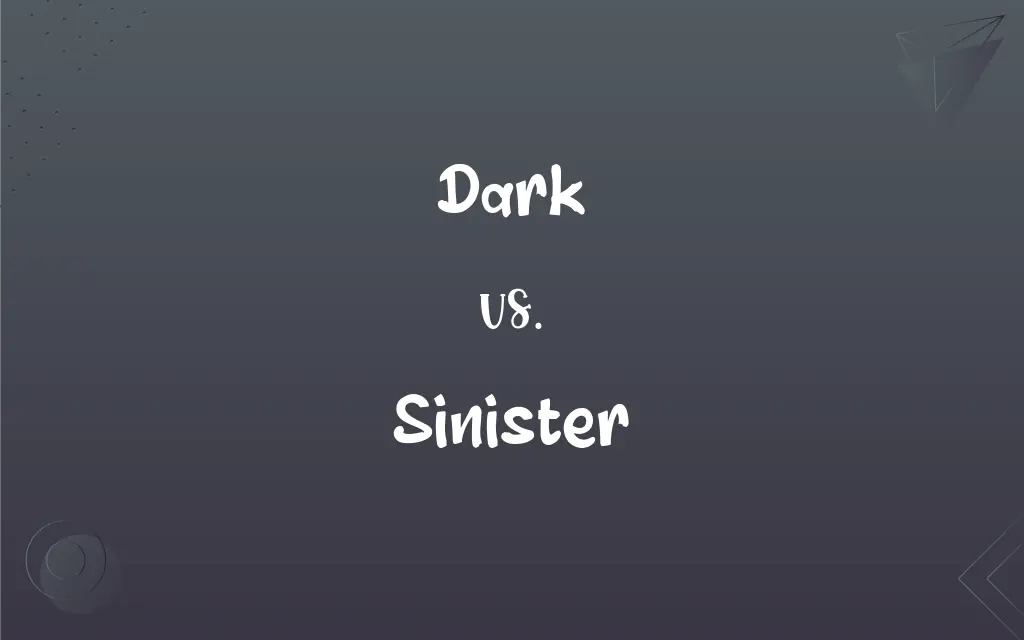Dark vs. Sinister: What's the Difference?
Edited by Aimie Carlson || By Janet White || Updated on November 29, 2023
Dark refers to the absence or low level of light, while sinister implies an evil, ominous, or threatening quality.

Key Differences
Dark generally pertains to the lack of light, resulting in low visibility or obscurity. Sinister, however, conveys a sense of evil, malignancy, or foreboding, often associated with malevolent intentions or outcomes.
In a literal sense, dark can describe physical darkness, as in a room with no light. In contrast, sinister has a metaphorical implication, suggesting something harmful or ominous lurking within a situation or character.
Dark can also be used metaphorically to describe a mood, tone, or aspect of a situation that is gloomy or pessimistic. Sinister, on the other hand, specifically implies a malevolent or threatening aspect to a situation or character.
Dark is often neutral in terms of moral implications, simply denoting the absence of light or clarity. Sinister inherently carries a negative connotation, indicating something wrong, evil, or harmful.
The term dark can apply to various contexts, from physical environments to themes in literature and art. Sinister, while also used in diverse contexts, consistently conveys a sense of wickedness or ominous threat.
ADVERTISEMENT
Comparison Chart
Literal Meaning
Absence or low level of light
Evil, ominous, or threatening quality
Metaphorical Use
Describes gloominess or pessimism
Implies malevolence or harmful intent
Moral Implication
Neutral, not inherently good or bad
Negative, often associated with evil or harm
Common Contexts
Physical environments, moods, literature, art
Situations, characters, intentions in stories
Emotional Connotation
Can be mysterious or unsettling
Always indicates something malevolent or wrong
ADVERTISEMENT
Dark and Sinister Definitions
Dark
Secretive or unknown.
He had a dark past that he rarely spoke about.
Sinister
Harmful or inauspicious.
They received a sinister warning about their journey.
Dark
Lacking or devoid of light.
The room was completely dark at night.
Sinister
Malevolent or wicked.
The plot involved a sinister conspiracy.
Dark
Gloomy or pessimistic in nature.
The movie had a dark and somber tone.
Sinister
Ominous or suggesting evil.
The villain had a sinister smile.
Dark
Suggesting a sense of mystery or danger.
The forest had a dark and foreboding presence.
Sinister
Threatening or portending harm.
There was a sinister feeling in the abandoned house.
Dark
Characterized by a deep or rich shade.
She wore a beautiful dress in dark blue.
Sinister
Indicative of future misfortune.
The dark clouds had a sinister appearance.
Dark
Lacking or having very little light
A dark corner.
Sinister
Suggesting or threatening harm or evil
A sinister smile.
FAQs
Is sinister always negative?
Yes, sinister typically carries a negative connotation, suggesting evil or harm.
What makes a character sinister?
A character is sinister if they exhibit malevolence, wickedness, or threatening behavior.
Can dark be used positively?
Yes, in some contexts, dark can have a positive or neutral connotation, like mystery or richness.
Can a situation be both dark and sinister?
Yes, a situation can be both dark (gloomy) and sinister (threatening).
Are dark themes common in literature?
Yes, dark themes like suffering, death, and evil are common in literature.
What does sinister mean?
Sinister implies an evil, ominous, or threatening quality.
Can dark refer to color?
Yes, dark can describe a deep or rich shade of color.
What is a dark comedy?
A dark comedy is a genre that combines humor with gloomy, morbid, or serious themes.
Can a mood be described as dark?
Yes, a mood can be described as dark, meaning gloomy or pessimistic.
What does dark mean?
Dark refers to the absence or low level of light, or metaphorically, to gloominess or pessimism.
How can a story be sinister?
A story can be sinister if it involves evil, malevolent, or ominous elements.
Can someone's intentions be sinister?
Yes, if their intentions are evil or harmful, they are considered sinister.
Is a sinister atmosphere always frightening?
A sinister atmosphere often implies fear, unease, or foreboding.
Can dark be used to describe secrets?
Yes, dark can describe something secretive, unknown, or concealed.
Is a dark sense of humor necessarily sinister?
Not necessarily; a dark sense of humor can be morbid or gloomy without being evil or harmful.
Can a place feel sinister?
Yes, places can feel sinister if they evoke a sense of evil or danger.
What does it mean when someone has a sinister reputation?
It means they are known for being evil, dangerous, or harmful.
How does a sinister plan differ from a mere bad plan?
A sinister plan specifically involves malevolent or evil intentions.
What is a dark horse?
A dark horse is a less-known person or thing that emerges to prominence, especially in a competition.
Is darkness always physical?
No, darkness can also be metaphorical, as in emotions or situations.
About Author
Written by
Janet WhiteJanet White has been an esteemed writer and blogger for Difference Wiki. Holding a Master's degree in Science and Medical Journalism from the prestigious Boston University, she has consistently demonstrated her expertise and passion for her field. When she's not immersed in her work, Janet relishes her time exercising, delving into a good book, and cherishing moments with friends and family.
Edited by
Aimie CarlsonAimie Carlson, holding a master's degree in English literature, is a fervent English language enthusiast. She lends her writing talents to Difference Wiki, a prominent website that specializes in comparisons, offering readers insightful analyses that both captivate and inform.
































































